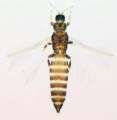Tenothrips frici
Recognition data
Distinguishing features
Both sexes fully winged. Body brown to dark brown, tarsi and fore tibiae paler; antennal segments III–V and basal half of VI yellow; fore wings light brown. Head wider than long; three pairs of ocellar setae present, pair III slightly longer than distance between hind ocelli, arising just anterior to these ocelli. Antennae 8-segmented; segments III–IV with short forked sensorium. Pronotum with transverse lines of sculpture; 2 pairs of long posteroangular setae; 4 pairs of posteromarginal setae. Metanotum weakly reticulate, posterior reticles forming distinctive arc at posterior margin; median setae arising at anterior margin; campaniform sensilla absent. Fore wing first vein with 2–4 setae on distal half; second vein with complete row of about 12 setae. Abdominal tergites III–VII with no sculpture medially; tergite VIII with no ctenidia but with several scattered microtrichia anterior to spiracle, posteromarginal comb with short microtrichia laterally but absent medially; tergite X with complete longitudinal split. Sternites without discal setae.
Male smaller than female; sternites III–VII with large oval pore plate occupying half the length of each sternite.
Variation
This common species in weedy yellow Asteraceae flowers is variable in body size and color, but has distinctive sculpture on the metanotum.
Related and similar species
There are 19 species listed in the genus Tenothrips, mainly from the Mediterranean region. However, Bhatti (2003) has questioned whether this genus is distinct from the Californian genus Ewartithrips.
Taxonomic data
Current valid name
Tenothrips frici (Uzel)
Original name and synonyms
- Physopus frici Uzel, 1895: 126
- Euthrips pallidicornis Karny, 1907: 45
- Euthrips dalmatica Karny, 1907: 45
- Physothrips brevicornis Bagnall, 1916: 220
- Physothrips blacki Watson, 1919: 32
- Taeniothrips alba Priesner, 1926: 291
- Taeniothrips pallidivestis Priesner, 1926: 291
- Taeniothrips fulva Knechtel, 1945: 457
- Taeniothrips adusta Knechtel, 1951: 139
- Taeniothrips persimilis Priesner, 1954: 51
- Taeniothrips cibiniensis Knechtel, 1965: 133
- Taeniothrips (Tenothrips) alis Bhatti, 1967: 18
Family placement
Thripidae, Thripinae
Common names
Mediterranean dandelion flower thrips
Biological data
Life history
Breeding in flowers.
Host plants
Associated with various Asteraceae, particularly weedy species.
Tospoviruses vectored
None
Crop damage
None
Distribution data
Area of origin
Mediterranean area.
Distribution
Widespread in southern Europe, introduced to California, Oregon, Washington, Georgia, Colombia, Argentina, Uruguay, Hawaii, New Zealand, southern Australia.






